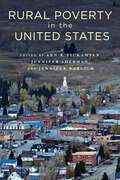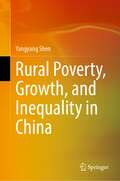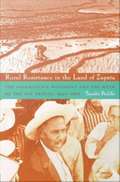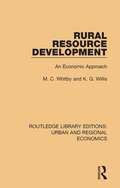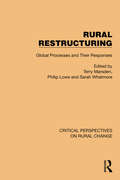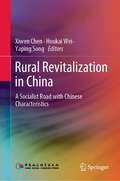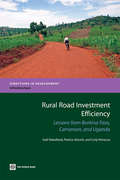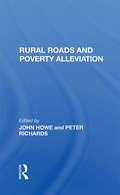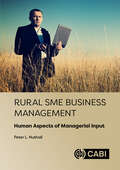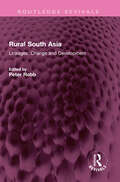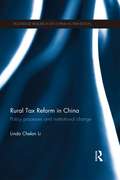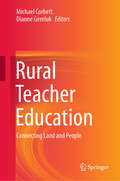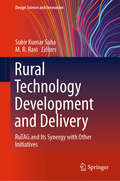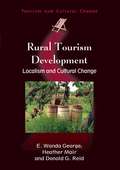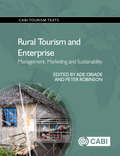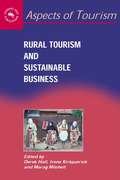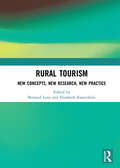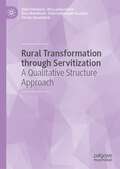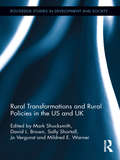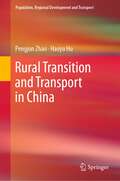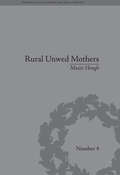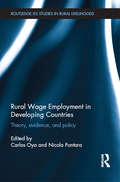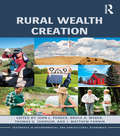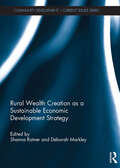- Table View
- List View
Rural Poverty in the United States
by Ann Tickamyer Jennifer Sherman Jennifer WarlickAmerica's rural areas have always held a disproportionate share of the nation's poorest populations. Rural Poverty in the United States examines why. What is it about the geography, demography, and history of rural communities that keeps them poor? In a comprehensive analysis that extends from the Civil War to the present, Rural Poverty in the United States looks at access to human and social capital; food security; healthcare and the environment; homelessness; gender roles and relations; racial inequalities; and immigration trends to isolate the underlying causes of persistent rural poverty.Contributors to this volume incorporate approaches from multiple disciplines, including sociology, economics, demography, race and gender studies, public health, education, criminal justice, social welfare, and other social science fields. They take a hard look at current and past programs to alleviate rural poverty and use their failures to suggest alternatives that could improve the well-being of rural Americans for years to come. These essays work hard to define rural poverty's specific metrics and markers, a critical step for building better policy and practice. Considering gender, race, and immigration, the book appreciates the overlooked structural and institutional dimensions of ongoing rural poverty and its larger social consequences.
Rural Poverty, Growth, and Inequality in China
by Yangyang ShenThis book aims to empirically and theoretically study how the economic growth and inequality affected China’s rural poverty since China’s reform and opening-up. Apart from the trickle-down effect, some empirical researches show that rising inequality usually links with unfairly shared of the economic growth, which is not good for the poor, and this book particularly concerns with the impact of inequality on poverty reduction. In 11 chapters, it leads readers to review the dynamic changes of rural poverty in China, and estimates rural poverty by various methods, for instance, with analysis by monetary poverty (including income and expenditure poverty), multidimensional poverty, absolute poverty, and relative poverty. Especially attention is paid to apply the “growth-inequality-poverty triangle” model for long-term poverty dynamic changes evaluation. The book revisits poverty reduction strategies in different development periods for rural China and evaluates the poverty eradication achievements stage-by-stage under different analytical methods, in order to provide an objective assessment. Among the chapters, pro-poor growth, Shapley decomposition, poverty elasticity, density estimation, multidimensional poverty analysis, and policy simulation methods are applied for both national wide discussion and rural sub-group heterogeneity analysis. In addition to students, teachers, and researchers in the areas of development, economic growth, equity, and welfare, the book is also of great interest to policy makers, planners, and non‐government agencies who are concerned with understanding and addressing poverty-related issues in the developing countries.
Rural Resistance in the Land of Zapata: The Jaramillista Movement and the Myth of the Pax PriÍsta, 1940-1962
by Tanalís PadillaIn Rural Resistance in the Land of Zapata, Tanals Padilla shows that the period from 1940 to 1968, generally viewed as a time of social and political stability in Mexico, actually saw numerous instances of popular discontent and widespread state repression. Padilla provides a detailed history of a mid-twentieth-century agrarian mobilization in the Mexican state of Morelos, the homeland of Emiliano Zapata. In so doing, she brings to the fore the continuities between the popular struggles surrounding the Mexican Revolution and contemporary rural uprisings such as the Zapatista rebellion. The peasants known in popular memory as Jaramillistas were led by Rubn Jaramillo (1900-1962). An agrarian leader from Morelos who participated in the Mexican Revolution and fought under Zapata, Jaramillo later became an outspoken defender of the rural poor. The Jaramillistas were inspired by the legacy of the Zapatistas, the peasant army that fought for land and community autonomy with particular tenacity during the Revolution. Padilla examines the way that the Jaramillistas used the legacy of Zapatismo but also transformed, expanded, and updated it in dialogue with other national and international political movements. The Jaramillistas fought persistently through legal channels for access to land, the means to work it, and sustainable prices for their products, but the Mexican government increasingly closed its doors to rural reform. The government ultimately responded with repression, pushing the Jaramillistas into armed struggle, and transforming their calls for local reform into a broader critique of capitalism. With Rural Resistance in the Land of Zapata, Padilla sheds new light on the decision to initiate armed struggle, women's challenges to patriarchal norms, and the ways that campesinos framed their demands in relation to national and international political developments.
Rural Resource Development: An Economic Approach (Routledge Library Editions: Urban and Regional Economics #24)
by M. C. Whitby K. G. WillisOriginally published in 1978. The question of how best to use our various resources has become one of crucial importance as we face today's many economic problems. In this second edition, the authors are concerned with decisions on rural issues in a climate of financial cut-backs, which emphasise the need for identifying the most efficient public choices. With a refreshing directness they consider immediate problems of rural resources, such as the growth of the public sector, fluctuating commodity prices, dislocation in the land market, pollution, recreation pressure, and modernisation of an outdated settlement structure. In Part one, chapters deal in turn with the economics of public decisions, the application of quantitative models in the development context, the planning system as it applies to rural areas, and the problems of conserving the rural environment. Part two deals with the individual topics: land use and conversion to other uses, recreational use of the countryside, conservation economics, rural population, the labour market and farm policies, rural transport, and rural settlement. The authors conclude with an examination of the Cow Green Reservoir as a case-study of a rural public issue which had to be resolved. This revised and considerably expanded edition focusses specifically on the economic aspects of the subject and provides further illustrations, diagrams and examples.
Rural Restructuring: Global Processes and Their Responses (Critical Perspectives on Rural Change #1)
by Sarah Whatmore Philip Lowe Terry MarsdenOriginally published in 1990, this volume discusses the broad theme of rural restructuring looking at the nature of rural related responses to global processes of change. This book provides global viewpoints which show readers a more integral and critical analysis on rural areas based on the changing realities of the 1990s.
Rural Revitalization in China: A Socialist Road with Chinese Characteristics
by Houkai Wei Xiwen Chen Yaping SongOn the basis of systematically summarizing and sorting out the significant achievements made since China's rural reform, this book comprehensively explains the theoretical basis, principles and strategies of the road to rural revitalization of socialism with Chinese characteristics. Through in-depth research on nine aspects of rural basic management system, rural deepening reform, food security, modernization of agriculture and rural areas, integrated development of urban and rural areas, poverty alleviation, new rural construction, ecological civilization construction and rural governance, this book puts forward the development direction and strategic choice of China's rural revitalization by the middle of this century. It not only enriches and develops the theory of development economics, but also provides experiences for rural development in developing countries.
Rural Road Investment Efficiency: Lessons from Burkina Faso, Cameroon, and Uganda
by Carly Petracco Patricia Macchi Gaël RaballandThe development aid community has placed a great deal of emphasis on the need for rural mobility in Sub-Saharan Africa (SSA). Thus far, most development partners and governments in SSA have relied on two overarching assumptions when dispensing transport aid-that most households in rural areas in Africa are not connected to markets and therefore need a road passable for a truck, and that roads with high levels of service are crucial in order to achieve high economic impact. Based on data collection from various sources in three SSA countries, 'Rural Road Investment Efficiency' demonstrates that from a cost-benefit perspective, the additional cost of extending an all-weather road two more kilometers to the farmer's door outweigh the benefits in most cases. 'Rural Road Investment Efficiency' seeks to enhance the effectiveness of aid allocated for rural transport in SSA and calls into question the need for full implementation of all benchmarks set forth in the Rural Access Index (RAI) in SSA. This book will be an essential reference for government supervisory authorities and infrastructure experts throughout the region.
Rural Roads And Poverty Alleviation (Rural Building Course Ser. #2)
by John Howe Peter Richards J D HoweThis book analyses the use of rural road networks and the causes and effects of road programmes in the areas of personal travel, education, health and poverty alleviation. It discusses the criteria which are being used for rural road selection and their impact in Egypt, India, Botswana and Thailand.
Rural SME Business Management: Human Aspects of Managerial Input
by Peter L NuthallThis book is about managerial ability and how it might be assessed and improved, and it focuses on rural Small and Medium Enterprises (SMEs). Traditionally, business studies have seldom covered the manager as a person and a decision maker in any great depth. Personnel management, production economics, financing, operations analysis techniques, etc. tend to be emphasized but the personal attributes of the decision makers have as much influence on success as the rules of good decision making. This book aims to correct this imbalance. The human characteristics of managers that define how a manager operates are explored, as are their impact on managerial ability. The details of the competencies a manager must possess are also presented and discussed as well as potential detracting biases. The book concludes with methods and techniques covering personal characteristic changes and associated managerial improvement. The concepts and conclusions of this book are all based on a body of research, excerpts of which are quoted in the text, drawn from the rich sources available in the international literature. Case studies describing successful managers and management advisors are used throughout. · First book which specifically focuses on human factors and decision making for SME managers. · Introduces new research specifically on the quantification of intuition, the primary decision making method used in SMEs. · Contains essential material required by researchers of decision making processes, business studies teachers, and extension workers from the world of SME business.
Rural South Asia: Linkages, Change and Development (Routledge Revivals)
by Peter RobbFirst published in 1983, Rural South Asia examines questions of change and development in terms of linkages between localities and the outside world. The authors examine the response specifically to the introduction of a ‘modern’ features of production, the importance of physical, cultural and economic communication, and the impact of various development efforts. This book will be of interest to student of South Asian studies, history, economics and agriculture.
Rural Taobao: Alibaba's Expansion into Rural E-Commerce
by Tarun Khanna Adam Frost Ryan Allen Wesley KooAlibaba's Rural Taobao initiative had been launched in 2014 as a public service initiative to increase e-commerce adoption in China's remote rural areas. In the first two iterations of the initiative, dubbed "1.0" and "2.0", Alibaba had partnered with local businesses and young returnees to operate village stations. Village stations served as logistical and educational hubs to help villagers make online purchases. Despite significant growth in sales through village stations, the business model was operating at a loss, and competitors JD and Pinduoduo were growing quickly, threatening to challenge Alibaba by claiming the rural e-commerce markets. Bill Wang, the head of the initiative, was tasked with designing and implementing the next model for Alibaba's future expansion into rural areas. The decision centers around whether Alibaba should copy the successes of competitors JD and Pinduoduo, escalate commitment to its original value proposition (hands-on service to villagers), or embrace an entirely new model. The case highlights the competing pressures of financial performance, CSR and corporate mission, government relations, and long-term competitive positioning that are common to major strategic decisions.
Rural Tax Reform in China: Policy Processes and Institutional Change (Routledge Studies on China in Transition)
by Linda Chelan LiThis book examines questions of change and inertia in the context of the longstanding grievances over excessive taxation in rural China. How can some changes be sustained, whilst others cannot? How can a longstanding administrative practice be changed or even terminated, especially when previous attempts at change have failed? Using extensive interview data with local and central bureaucrats, Li's findings highlight the role of parallel developments and agency in the change process, as well as the prevalence of contingency and uncertainty. It also elegantly blends the narrative of the rural tax and administrative reforms with theoretical discussions to deepen our understanding of policy process and institutional change in 21st century China. Despite the authoritarian political system, the Chinese state-in-action which emerges from this book sees actions stemming from both the central and local levels, mediated by strategic design as well as contingency. This book will be of interest to students and scholars of Chinese Studies, political science and policy and development studies.
Rural Teacher Education: Connecting Land and People
by Michael Corbett Dianne GerelukThis book examines challenges associated with the education of teachers in and for rural places. It offers a new perspective with respect to how Canadian educators are shifting the conversation toward a hopeful discourse concerning how educators can foster meaningful rural learning environments, which will contribute to building stronger rural communities and regions. A central focus of the book is emerging reconceptualization of education, place and indigeneity in Canadian education in the wake of the Truth and Reconciliation CommissionThough the challenge of addressing rural teaching and learning lies partly in the nuances and complexities of unique places, there are also common threads that affect virtually all communities in rural, regional and remote educational, cultural, economic, and social geographies. Chapters in this collection provide current research in Canadian rural education including examples and stories from the field – contributed by teachers, administrators, and superintendents – on the challenges and creative opportunities that they have discovered in their own rural context, giving hope and inspiration for what is possible. The book will appeal to all readers interested in rural education and teacher education, as well as to those concerned with educational inequality and indigenous education.
Rural Technology Development and Delivery: RuTAG and Its Synergy with Other Initiatives (Design Science and Innovation)
by Subir Kumar Saha M. R. RaviThis book comprises the proceedings of a rural technologies conference organised by the Rural Technology Action Group (RuTAG), which was conceptualized and initiated by Principal Scientific Adviser (PSA) to the Government of India R. Chidambaram in 2003–04. The book highlights case studies and research into providing science and technology interventions for the development of rural areas. Covering various aspects of research carried out in the area of rural technologies, it offers a valuable resource for researchers, professionals, and policymakers alike.
Rural Tourism Development
by Heather Mair E. Wanda GeorgeRural tourism represents a merging of perhaps two of the most influential yet contradictory features of modern life. Not only are the forces of economic, social, cultural, environmental and political change working to redefine rural spaces the world over, but broad global transformations in consumption and transportation patterns are reshaping leisure behaviour and travel. For those concerned with both the nature of change in rural areas and tourism development, the dynamics and impacts of integrating these two dramatic shifts are not well known but yet are becoming increasingly provocative discourses for study. This book links changes at the local, rural community level to broader, more structural considerations of globalization and allows for a deeper, more theoretically sophisticated consideration of the various forces and features of rural tourism development. While Canadian in content, the cases and discussions presented in this book can be considered generally relevant to any rural region, continentally and globally, that has undertaken or is considering rural tourism development.
Rural Tourism and Enterprise: Management, Marketing and Sustainability (CABI Tourism Texts)
by Neil Robinson Michael Evans Crispin Dale Steve Gelder Caroline Wiscombe Sine Heitmann Peter Wiltshier Roya Rahimi Dr Sammy Li Dr Solomon Olorunfemi Olubiyo Dr Abiodun Elijah Obayelu Dr Vivienne Saverimuttu Dr Weng Marc Lim Dr Anahita Malek Tony Greenwood Dr Ainurul Rosli Dr Nikolaos Stylos Dr Elizabeth Heyworth-Thomas Dr Sandy Ryder Dr Lucy Maynard Dr Maria Estela Varua Dr Fabio Carbone Dr Asia Alder Dr Maria Granados Dr Jane Chang Dr Charles DobsonMarketing and management processes across industries can be very similar, but contexts vary where political intervention, public interest and local sustainability are involved. The rural business setting is especially intricate due to the assortment of different business opportunities, ranging from traditional agriculture, to tourism enterprise and even high-tech business. This important new textbook on the subject: - Examines key issues affecting rural enterprise and tourism - Explores the breadth of rural enterprise management and marketing across both developed and developing economies - Discusses strategies for business growth within a rural setting, such as knowledge development, proper planning and innovation - Uses a mix of case studies and theoretical content specifically selected to appeal to both student and practitioner readers Including pedagogical features and full colour throughout, this new textbook provides an engaging and thought-provoking resource for students and practitioners of tourism, rural business and related industries.
Rural Tourism and Sustainable Business
by Derek R. Hall Irene KirkpatrickThis book provides the latest conceptual thinking on, and case study exemplification of, rural tourism and sustainable business development from Europe, North America, Australasia, the Middle East and Japan in 19 concise, manageable chapters. The book is organised into distinct yet interrelated sections, and benefits from strong editorial input in terms of context setting and summary chapters. Rural Tourism and Sustainable Business represents a high quality text integrating the latest thinking on the evolving strategic roles of rural tourism and its role in sustainable business development. It provides readily accessible material drawn from a range of environmental and cultural contexts and draws attention to the nature and interrelationships between local and global issues in rural tourism and development.
Rural Tourism: New Concepts, New Research, New Practice
by Bernard Lane and Elisabeth KastenholzThis book describes, analyses, celebrates and interrogates the rise of rural tourism in the developed world over the last thirty years, while explaining its need to enter a new, second generation of development if it is to remain sustainable in all senses of that word. Contributors include 29 leading researchers, practitioners and commentators from ten countries around the world. Subjects covered include the ongoing evolution of rural tourism as a genre; its numerous niche markets, and market trends; community involvement, and its impacts on rural landscape conservation and society. Special attention is paid to product development in rural tourism, including food and beverage tourism, avitourism and landscape appreciation. Management Issues are also dealt with, as is the impact of internet booking systems on both commercial performance and regional and national rural tourism governance. There is a review of trends in academic research in rural tourism with an analysis of 1848 refereed and published research papers since 2000. This book is a worthy successor to Bramwell & Lane’s pioneering 1994 publication, Rural Tourism and Sustainable Rural Development. This book was originally published as a special issue of the Journal of Sustainable Tourism.
Rural Transformation through Servitization: A Qualitative Structure Approach
by Dalia Vidickienė Živilė Gedminaitė-Raudonė Vitalija Simonaitytė Rita Lankauskienė Rasa MelnikienėRural development paradigms after the Second World War depended on a set of assumptions relevant to the mass-scale industrialization of the agricultural sector. However, most of these assumptions are now invalid and we need strategies for redesigning the industrial economic system to co-create value according to the rules of post-industrial society. To grasp better what drives today's rural development, this book conducts an analysis of qualitative changes in economic and social life caused by a major innovation model inherent to post-industrial society – servitization. The book aims to contribute to the scarce literature on the role of servitization in farming and rural development. It offers a conceptual and empirical understanding of the ways of servitization in agriculture and rural development, examined through the prism of an evolutionary approach based on the theory of qualitative structure. The method of qualitative structure explains why and how a switch from product-oriented business logic to service-oriented business logic happens and helps to find many new insights useful for improving farm management and socio-economic development of rural regions. It combines a systematic and evolutionary analysis of literature on servitization and agricultural production strategies with case studies of farming and territorial servitization projects implemented in Lithuania. It will be of great interest to researchers and students in the field of rural development studies, servitization and business model innovation.
Rural Transformations and Rural Policies in the US and UK (Routledge Studies in Development and Society)
by David L. Brown Sally Shortall Jo Vergunst Mark Shucksmith Mildred E. WarnerThis book examines the transformations of rural society and economy in the UK and US during the last half-century, and explores the significance of these trends and changes for community sustainability, quality of life and the environment. While both the UK and US are highly urbanised, rural people and communities continue to contribute to national identity, economic development and social solidarity, as well as to environmental quality. Contributors explore the degree to which rural people exhibit agency and autonomy, rather than being merely passive in the face of exogenous forces of change in a globalised world. They also illuminate very different policy approaches to rural policy in two advanced capitalist societies often thought to be similar, and show how fundamental differences in rural policy approaches of the US and the UK are based on different social ideologies and values that shape policies relating to rural areas. This book will help to stimulate transatlantic dialogue on rural scholarship and rural policy analysis, while also contributing to theory and policy development. It will be of interest to researchers, students and everyone involved in the policy and practice of rural development.
Rural Transition and Transport in China (Population, Regional Development and Transport)
by Pengjun Zhao Haoyu HuThis book examines the rural transition and transportation in China. It covers demographic change, settlement transformation, and infrastructure development in rural areas, as well as changes in transportation expenditures, travel behavior, and accessibility of basic public services among rural Chinese residents. The book contributes to the new body of knowledge from an international perspective in three ways. First, it explores the changes in travel behavior of rural residents and related factors. Second, it provides new evidence on the relationship between rural social transformation and transportation infrastructure development. Third, it discusses the impact of transportation investments on rural poverty reduction. The book enhances our understanding of the changes in travel behavior of rural residents. In particular, the results of the multi-source big data analysis will provide new evidence on the link between social transformation and changes in travel behavior in rural China. It also helps planners and politicians to develop policies aimed at improving quality of life, rural poverty, and the efficiency of transportation investments in rural areas. The book is of great interest to scholars interested in rural transformation and development, sustainable transport, regional planning, and environmental policy and is relevant to China and other developing countries.
Rural Unwed Mothers: An American Experience, 1870-1950 (Perspectives in Economic and Social History #4)
by Mazie HoughDrawing extensively from agency records, newspaper accounts, sociological studies and court documents, Hough explores the experiences of rural white unwed mothers in Maine and Tennessee.
Rural Wage Employment in Developing Countries: Theory, Evidence, and Policy (Routledge ISS Studies in Rural Livelihoods)
by Carlos Oya Nicola PontaraThere is a striking scarcity of work conducted on rural labour markets in the developing world, particularly in Africa. This book aims to fill this gap by bringing together a group of contributors who boast substantial field experience researching rural wage employment in various developing countries. It provides critical perspectives on mainstream approaches to rural/agrarian development, and analysis of agrarian change and rural transformations from a long-term perspective. This book challenges the notion that rural areas in low- and middle-income countries are dominated by self-employment. It purports that this conventional view is largely due to the application of conceptual frameworks and statistical conventions that are ill-equipped to capture labour market participation. The contributions in this book offer a variety of methodological lessons for the study of rural labour markets, focusing in particular on the use of mixed methods in micro-level field research, and more emphasis on capturing occupation multiplicity. The emphasis on context, history, and specific configurations of power relations affecting rural labour market outcomes are key and reoccurring features of this book. This analysis will help readers think about policy options to improve the quantity and quality of rural wage employment, their impact on the poorest rural people, and their political feasibility in each context.
Rural Wealth Creation (Routledge Textbooks in Environmental and Agricultural Economics)
by John L. Pender Bruce A. Weber Thomas G. Johnson J. Matthew FanninThis book investigates the role of wealth in achieving sustainable rural economic development. The authors define wealth as all assets net of liabilities that can contribute to well-being, and they provide examples of many forms of capital – physical, financial, human, natural, social, and others. They propose a conceptual framework for rural wealth creation that considers how multiple forms of wealth provide opportunities for rural development, and how development strategies affect the dynamics of wealth. They also provide a new accounting framework for measuring wealth stocks and flows. These conceptual frameworks are employed in case study chapters on measuring rural wealth and on rural wealth creation strategies. Rural Wealth Creation makes numerous contributions to research on sustainable rural development. Important distinctions are drawn to help guide wealth measurement, such as the difference between the wealth located within a region and the wealth owned by residents of a region, and privately owned versus publicly owned wealth. Case study chapters illustrate these distinctions and demonstrate how different forms of wealth can be measured. Several key hypotheses are proposed about the process of rural wealth creation, and these are investigated by case study chapters assessing common rural development strategies, such as promoting rural energy industries and amenity-based development. Based on these case studies, a typology of rural wealth creation strategies is proposed and an approach to mapping the potential of such strategies in different contexts is demonstrated. This book will be relevant to students, researchers, and policy makers looking at rural community development, sustainable economic development, and wealth measurement.
Rural Wealth Creation as a Sustainable Economic Development Strategy
by Shanna Ratner and Deborah MarkleyMany rural areas in the United States find themselves struggling to build local assets and create wealth, and, when this wealth is created, they often struggle to hold on it. Previous approaches to community and economic development have been inadequate in attempting to reverse these trends. Shifting to a new way of enabling economic development requires supporting innovative community leaders as they explore new ways of approaching the task at hand. It also requires thinking anew about the role of rural areas, based on valuing multiple forms of wealth – natural, social, and human. There is a real need for an approach that can help stem the potential loss of existing wealth, and attract new investment that will allow rural areas to become valued partners in regional economies. This book provides an important insight into rural wealth creation as a sustainable economic development strategy. At the same time, a number of compelling issues are raised that merit future research effort and discussion. This book was originally published as a special issue of Community Development.
